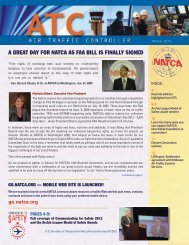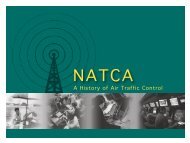Against the Wind - National Air Traffic Controllers Association
Against the Wind - National Air Traffic Controllers Association
Against the Wind - National Air Traffic Controllers Association
You also want an ePaper? Increase the reach of your titles
YUMPU automatically turns print PDFs into web optimized ePapers that Google loves.
226<br />
<strong>Against</strong> <strong>the</strong> <strong>Wind</strong><br />
The bottom line: NATCA argues that<br />
<strong>the</strong> drive for profits in a privatized ATC<br />
system competes against safety in terms of<br />
adequate staffing and training.<br />
* Despite fifty-seven co-sponsors, Ford’s bill<br />
never came up for a vote in <strong>the</strong> Senate.<br />
** The Transportation Trades Department is an<br />
umbrella organization composed of thirtyfour<br />
AFL-CIO unions representing aviation,<br />
rail, transit, trucking, highway, and longshore<br />
workers.<br />
2001<br />
badly needed equipment upgrades. The union supported<br />
Sen. Wendell Ford’s bill for an independent<br />
FAA in 1988 and worked with <strong>the</strong> Clinton administration<br />
to create its USATS plan in <strong>the</strong> mid-1990s. *<br />
However, NATCA opposed privatization and<br />
fur<strong>the</strong>r contracting out. It<br />
also kept a watchful eye<br />
on o<strong>the</strong>r proposals. When<br />
<strong>the</strong> Clinton administration<br />
drafted an executive<br />
order in late 2000 to create<br />
a performance-based<br />
organization, <strong>the</strong> union’s top two officers and <strong>the</strong><br />
Transportation Trades Department’s executive director<br />
attended a White House meeting to help ensure<br />
that <strong>the</strong> mandate described air traffic control as an<br />
inherently governmental function. **<br />
Saving jobs was not NATCA’s sole concern.<br />
Many members worried about <strong>the</strong> inevitable tradeoff<br />
between safety and <strong>the</strong> bottom line. Bill “Blackie”<br />
Blackmer, a former director of safety and technology<br />
for <strong>the</strong> union, says ever-increasing traffic puts pressure<br />
on controllers, whose adherence to safety margins<br />
can result in delays. “What scares our people<br />
most is <strong>the</strong> pressure we’d feel in <strong>the</strong> private world.”<br />
One measure of that influence and <strong>the</strong> effect of<br />
mounting traffic is <strong>the</strong> number of near misses on <strong>the</strong><br />
ground, referred to as runway incursions. A record<br />
431 incidents were reported in <strong>the</strong> United States<br />
Jan. Feb.<br />
30<br />
NATCA signs two collective bargaining agreements with <strong>the</strong><br />
FAA representing engineers/architects and traffic management<br />
specialists.<br />
28<br />
during 2000—or more than one a day. The <strong>National</strong><br />
Transportation Safety Board considered <strong>the</strong> problem<br />
so acute that it listed prevention of runway incursions<br />
as one of its most-wanted safety improvements.<br />
While many incidents are relatively minor,<br />
<strong>the</strong> potential for disaster is<br />
always present. Aviation’s<br />
worst accident in history<br />
occurred when two Boeing<br />
747s collided on a<br />
fog-shrouded runway on<br />
Tenerife in <strong>the</strong> Canary Islands<br />
in 1977, killing 582 people.<br />
NATCA feared, with some justification, that<br />
a privatized system would create an acute staffing<br />
shortage and compromise safety. Its neighbor to <strong>the</strong><br />
north provides an example of a privatized model.<br />
Nav Canada, a nonprofit corporation, paid <strong>the</strong><br />
Canadian government C$1.5 billion to take over air<br />
traffic control operations in 1996. <strong>Air</strong>lines and o<strong>the</strong>r<br />
users pay Nav Canada fees for its services. The firm<br />
estimated that airlines saved more than C$225 million<br />
in fiscal year 2000 compared with <strong>the</strong>ir previous<br />
costs under Canada’s air transportation tax. 2<br />
Although Nav Canada has spent C$500 million<br />
on modernization, <strong>the</strong> Canadian <strong>Air</strong> <strong>Traffic</strong><br />
Control <strong>Association</strong> maintains that some of <strong>the</strong> savings<br />
should have been allocated for fur<strong>the</strong>r improvements.<br />
O<strong>the</strong>r savings have come from Nav Canada’s<br />
A 6.1-magnitude temblor severely damages <strong>the</strong> Seattle-Tacoma<br />
International <strong>Air</strong>port control tower. Ignoring orders to evacuate,<br />
Brian Schimpf clears twelve remaining arrivals to land.




